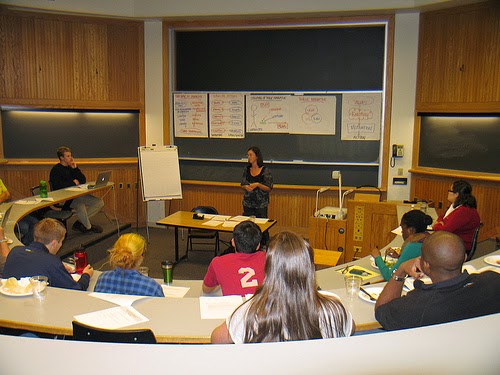Menu
- Public Policy
- Leadership
- Funding
- News & Events
- About the Center
Back to Top Nav
Back to Top Nav
Back to Top Nav
Back to Top Nav
This ongoing series explores sessions of the Management and Leadership Development Program (MLDP) through participant narratives. MLDP is a one-term program designed to develop citizen leaders among sophomores, juniors, and seniors at Dartmouth College. Led by expert guest speakers each week, sessions employ experiential teaching techniques to engage students through hands-on learning of core management and leadership skills.
 |
| Kate Hilton collaborates with MLDP participants during a session. |
Kate Hilton ’99, consultant at the Hauser Center for Nonprofit Organizations at Harvard University, led this session on using public narrative – stories – to motivate others to join a cause. There are three types of stories: the story of self, (who am I, and why am I called to do this work); the story of us (who are we as a community and why do we feel the obligation to take action), and the story of now (what we are called to do right now, what the challenges are, what our strategy is, and what hope we have of accomplishing our mission). These stories go beyond presenting good ideas as the basis to join in action; they appeal to one’s values and emotions, often the strongest motivators in getting people to act and to stay committed to a cause or campaign. Public narrative’s usefulness is in combining head (analysis/strategy) and heart (narrative) to produce shared understanding, leading to action of hands and feet.
Hilton asked the participants to spend a minute thinking about a story of us – what each person could ask others to join him/her in doing; how he or she could motivate others; say why he/she was called to be a leader in that endeavor; what life event sparked the interest; and what the choice point was. Rather than tell a story, she encouraged participants to draw a picture. Following this, she conducted a small-group exercise in which each person told a story, then gave feedback. Hilton then asked for a group to volunteer someone who told a good story to tell it to the whole group. Christine Souffrant ’11, a Haitian American, told her story about Haiti’s moment of independence, a glorious moment, then the Haitian earthquake, which killed so many people and totally disrupted life. Her story showed emotion but went beyond to say how much she wants to help Haiti and how others can join her in helping – conducting fundraisers, telling the story. Her story caught the audience’s attention, conveyed her values, related the audience to her culture, and promoted a cause. When getting people to join you in a story, Hilton advised, be specific in saying how to join you. Give a clear path. For example, “I’d like you all to join me on this date, time, to do thus and such.”
Hilton talked about body language, with slides, that shows whether we’re listening to a speaker, what it says about us as listeners. When telling stories, be dynamic, confident, allow vulnerability, eye contact, posture.
To illustrate public speaking skills as an aid to public narrative, Hilton showed President Obama giving his Democratic Convention speech, telling his story of self, now, us. She asked participants to watch his stance, posture, etc. to assess his public speaking skills. Obama’s speech was honest, spoken with pride, clearly, slowly. He thanked those who helped him get to that place, related his story to America’s story. He inspired people to see the greatness of America and to take pride in it, engage in its dreams. His call to action was that there is more work to do, and he mentioned the challenges that would go along with that work.
Hilton had the small groups meet again, retelling their stories, practicing public speaking, and providing feedback. She ended the session by saying that she enjoyed the group and thanked them for being both engaged and engaging.